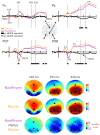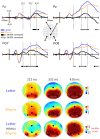Event Related Potentials Reveal Early Phonological and Orthographic Processing of Single Letters in Letter-Detection and Letter-Rhyme Paradigms
- PMID: 27148023
- PMCID: PMC4840210
- DOI: 10.3389/fnhum.2016.00176
Event Related Potentials Reveal Early Phonological and Orthographic Processing of Single Letters in Letter-Detection and Letter-Rhyme Paradigms
Abstract
Introduction: When and where phonological processing occurs in the brain is still under some debate. Most paired-rhyme and phonological priming studies used word stimuli, which involve complex neural networks for word recognition and semantics. This study investigates early (<300 ms) and late (>300 ms) orthographic and phonological processing of letters.
Methods: Fifteen participants aged 20-35 engaged in three two-forced choice experiments, one letter-detection (LetterID) and two letter-rhyme (Paired-Rhyme and Letter-Rhyme) tasks. From the EEG recordings, event related potential (ERP) differences within and across task stimuli were found. We also calculated the global field power (GFP) for each participant. Accuracies and reaction times were also measured from their button presses for each task.
Results: Behavioral: Reaction times were 18 ms faster to letter than pseudoletter stimuli, and 27 ms faster to rhyme than nonrhyme stimuli.
Erp/gfp: In the LetterID task, grand-mean evoked potentials (EPs) showed typical P1, N1, P2, and P3 waveform morphologies to letter and pseudoletter stimuli, with GFPs to pseudoletters being greater than letters from 160-600 ms. Across both rhyme tasks, there were greater negativities for nonrhyme than for rhyme stimuli at 145 ms and 426 ms. The P2 effect for rhyme stimuli was smaller than letter stimuli when compared across tasks.
Conclusion: Differences in early processing of letters vs. pseudoletters between 130-190 ms suggest that letters are processed earlier and perhaps faster in the brain than pseudoletters. The P2 effect between letter and rhyme stimuli likely reflect sublexical phonological processing. Together, findings from our study fill in evidence for the temporal dynamics of orthographic and phonological processing of single letters.
Keywords: EEG; event related potentials; evoked potentials; global field power; language; letter processing.
Figures






References
-
- Benjamini Y., Hochberg Y. (1995). Controlling the false discovery rate: a practical and powerful approach to multiple testing. J. R. Stat. Soc. Series B Methodol. 57, 289–300. 10.2307/2346101 - DOI
LinkOut - more resources
Full Text Sources
Other Literature Sources

